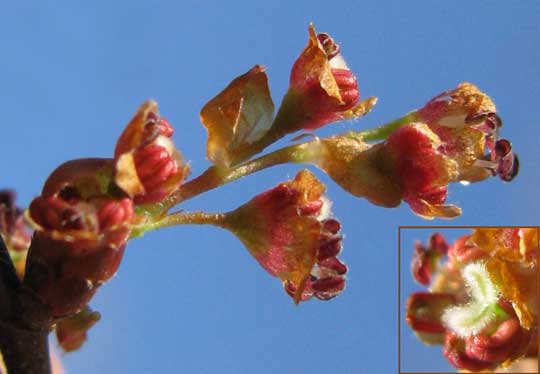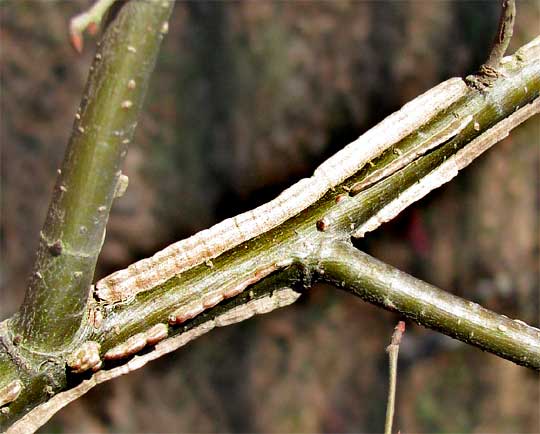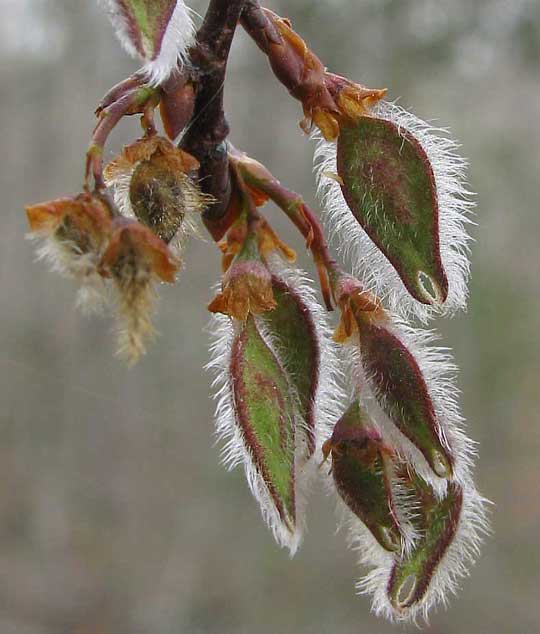Excerpts from Jim Conrad's
Naturalist Newsletter
from the February 2, 2009 Newsletter, issued from the forest near Natchez, Mississippi; elevation ~400ft (120m), ~N31.47°, ~W91.29°:
WINGED ELMS FLOWERING
Already in the last week of January our Winged Elms, ULMUS ALATA, have been producing postage-stamp-size flower clusters, or inflorescences, as shown below:

In that image a flower cluster emerges from a scale- covered, spherical bud at the left. Each cup-shaped blossom is smaller than a BB. The flowers have no corolla; the reddish, cuplike thing is the calyx and the calyx's brownish, petal-like lobes are sepals -- "petaloid" sepals, or sepals looking like petals.
In each blossom the red, frankfurter-like items peeping from the calyx cup are pollen-producing anthers. In the center of each flower the two white, fuzzy things are styles with hairy "stigmatic zones" along their inner edges. Remember that the female part of a flower, the pistil, typically consists of the stigma, style and ovary. Pollen germinates on the stigma, the male sex germ migrates in a pollen tube down through the slender, neck-like style, and unites with the female sex germ in an ovule inside the ovary. Ovules mature into seeds and ovaries into fruits bearing the seeds.
So, in elm flowers the stigmas and styles are merged, the "stigmatic surface" lining one side of the slender style. The inset at the lower right shows a flower's two fuzzy style arms.
Winged Elms are most easily identified by the tough, corky "wings" adorning their twigs, as shown below:
 .
.
However, stems on the tree whose flowers I photographed bore no corky wings at all, so how could I be certain that I wasn't photographing an American Elm or a Red Elm, which also are common here? Red Elm flowers have no or very short stems, or pedicles, while you can see that each Winged Elm flower arises from a slender pedicle. Pedicels of American Elm flowers all arise from one spot, like long-stemmed roses emerging from a narrow-necked vase. You can see that our Winged Elm's flower pedicles arise from along a slender central axis.
from the March 2, 2009 Newsletter, issued from the forest near Natchez, Mississippi; elevation ~400ft (120m), ~N31.47°, ~W91.29°:
WINGED ELMS FRUITIN
Nowadays beneath the Winged Elm trees in many places it looks like someone has scattered green confetti, for the trees are dropping their fruits, or samaras, en masse. Sometimes when a breeze comes along they fall in showers. You can see some fruits still dangling at the ends of branches below:

American Elms are producing similar samaras at this time. Since most of our larger Winged Elm trees bear wingless, leafless twigs looking a lot like American Elms, it's good to be able to distinguish the two similar species' samaras.
Mainly, Winged Elm samaras bear those very long white hairs along the edges. Hairs on American Elm samara rims are shorter, and Slippery Elm (also common here and also fruiting now) has no hairs on its fruit rims.
Also, notice that the flat faces on the Winged Elm samaras bear some short hairs. American Elm samaras are hairless, or glabrous, on the faces above the seed.
These seem like very obscure details, but when you need to distinguish species and all you have is samaras, you're glad to know about such things.